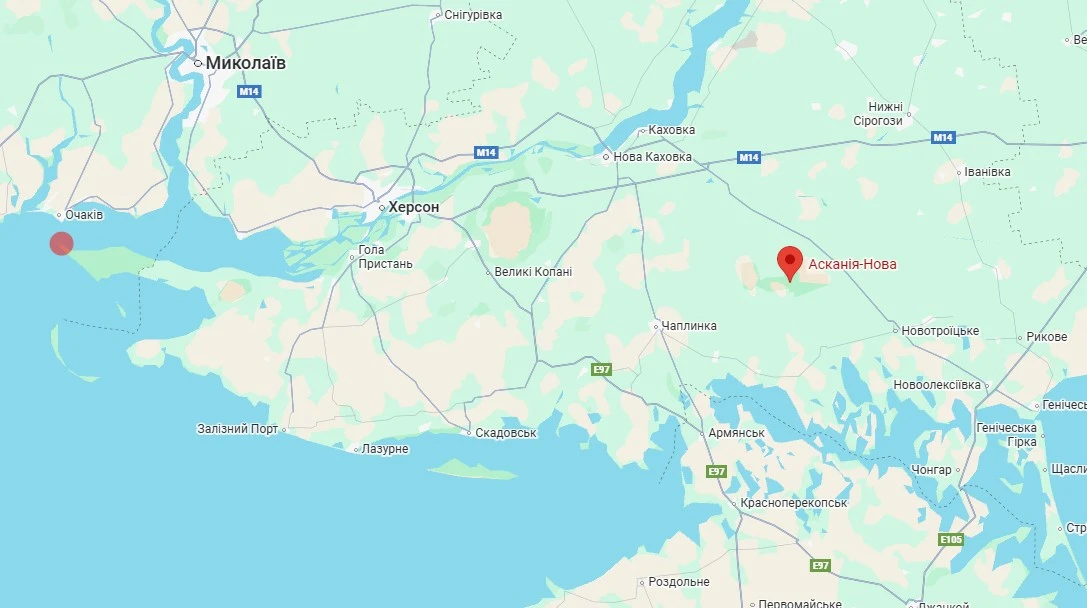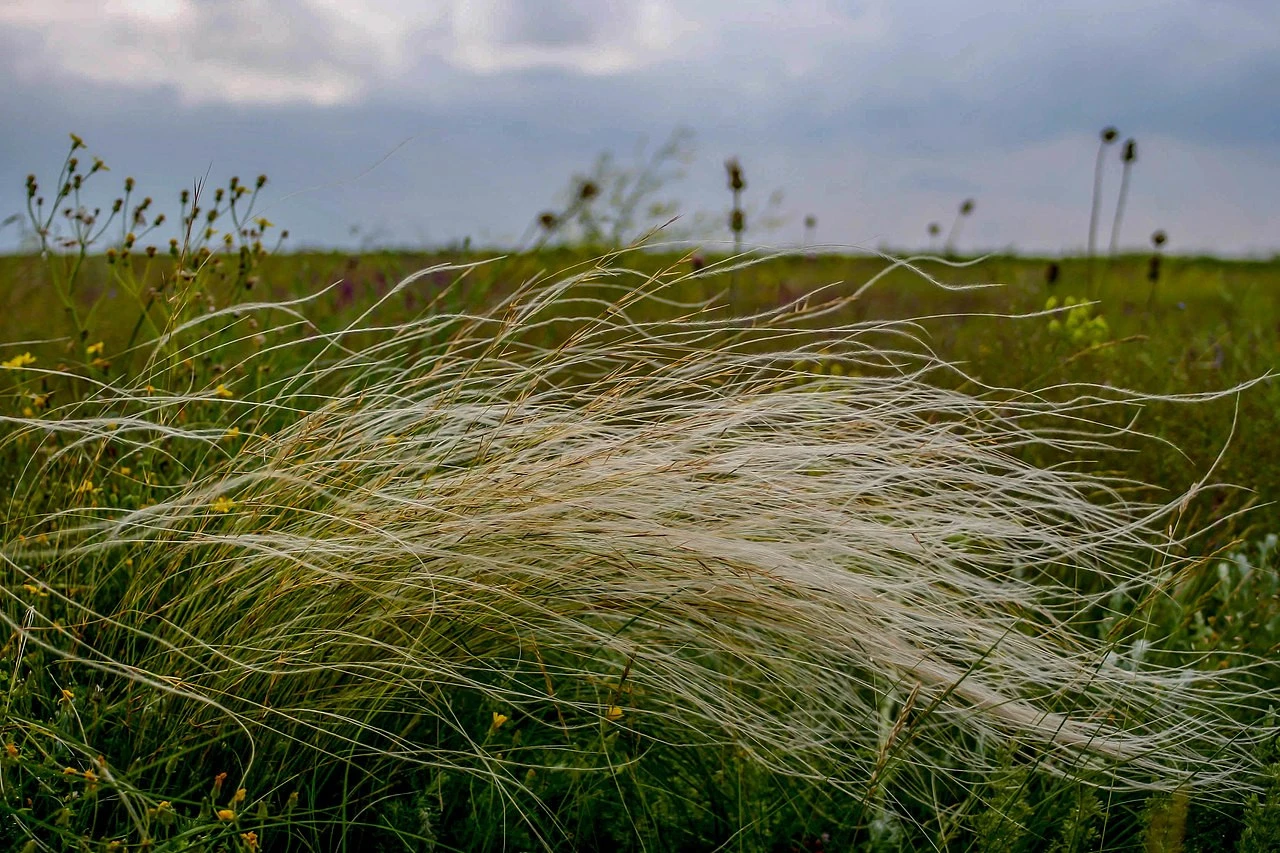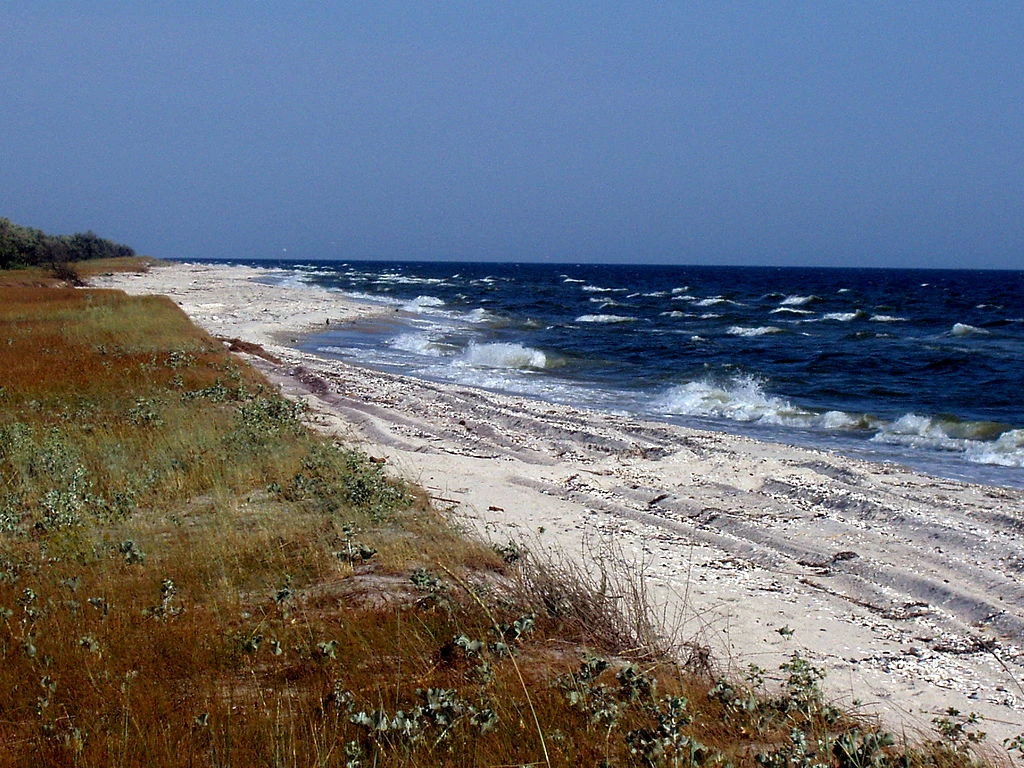Russian aggression lays waste to world's only untouched steppes in Ukraine
global.espreso.tv
Thu, 06 Nov 2025 20:18:00 +0200

On Thursday, November 6, the spokesman for the Ukrainian Navy, Dmytro Pletenchuk, stated on the national telethon that the Russians have practically destroyed the Kinburn Spit and the Askania-Nova reserve.  However, ecologist Oleh Lystopad commented to Espreso that to definitively assess the situation, one would need to visit the area. "But ecologists cannot go there due to the war," he said.Lystopad explains that the greatest value of this reserve and the spit before the war lay in their unique steppes, which had never been plowed, meaning they remained untouched by human activity.
However, ecologist Oleh Lystopad commented to Espreso that to definitively assess the situation, one would need to visit the area. "But ecologists cannot go there due to the war," he said.Lystopad explains that the greatest value of this reserve and the spit before the war lay in their unique steppes, which had never been plowed, meaning they remained untouched by human activity.  "There is no other large steppe massif like it anywhere else. Although for people, the zoo in Askania-Nova is more illustrative and obvious. Of course, it's always a pity for the animals – for example, there were African species there, and it's sad. But, to be honest, I don't consider this the greatest loss, however cynical it may sound. Because the main problem is that the steppe has literally begun to be 'plowed' by shell and ammunition impacts."Regarding the spit: it has unique coastal vegetation – a combination of steppe and coastal ecosystems. Many red-listed species are tied to these areas. The biggest problem is that the Russians have set up a training ground and outpost there, and due to constant fires, everything has burned out," the expert notes. The ecologist emphasizes that when small areas burn, there is no tragedy, as these are natural processes. But when everything burns and plants do not have time to recover, and animals do not have time to relocate, that is a real tragedy."Of course, if the Russians leave, then restoration will begin. Because nature has its own mechanisms of self-restoration. This process, in my opinion, is still possible with Askania-Nova, but with the Kinburn Spit, the situation is more complicated," Oleh Lystopad stressed.Askania-Nova: how it originatedThe Askania-Nova Biosphere Reserve in the Kherson region is one of the oldest steppe reserves in the world and the largest massif of untouched virgin steppe in Europe, which had truly never been plowed before. Its history begins at the end of the 19th century: in 1898, German colonist Friedrich Falz-Fein created a private protected steppe and the first large open-type menagerie in Europe here. Later, the territory was expanded, and in the 20th century, Askania became a scientific center for studying steppe biodiversity, animal acclimatization, and ecosystem protection.The main value of Askania is the steppe, untouched for centuries. It preserves the natural structure of vegetation, soils, and micro-ecosystems. This is a place where rare species of feather grass grow, hundreds of species of birds, reptiles, small steppe animals live, as well as animals from different continents that were kept in Falz-Fein's zoo.Kinburn Spit: A natural 'island' between the sea and the estuary
"There is no other large steppe massif like it anywhere else. Although for people, the zoo in Askania-Nova is more illustrative and obvious. Of course, it's always a pity for the animals – for example, there were African species there, and it's sad. But, to be honest, I don't consider this the greatest loss, however cynical it may sound. Because the main problem is that the steppe has literally begun to be 'plowed' by shell and ammunition impacts."Regarding the spit: it has unique coastal vegetation – a combination of steppe and coastal ecosystems. Many red-listed species are tied to these areas. The biggest problem is that the Russians have set up a training ground and outpost there, and due to constant fires, everything has burned out," the expert notes. The ecologist emphasizes that when small areas burn, there is no tragedy, as these are natural processes. But when everything burns and plants do not have time to recover, and animals do not have time to relocate, that is a real tragedy."Of course, if the Russians leave, then restoration will begin. Because nature has its own mechanisms of self-restoration. This process, in my opinion, is still possible with Askania-Nova, but with the Kinburn Spit, the situation is more complicated," Oleh Lystopad stressed.Askania-Nova: how it originatedThe Askania-Nova Biosphere Reserve in the Kherson region is one of the oldest steppe reserves in the world and the largest massif of untouched virgin steppe in Europe, which had truly never been plowed before. Its history begins at the end of the 19th century: in 1898, German colonist Friedrich Falz-Fein created a private protected steppe and the first large open-type menagerie in Europe here. Later, the territory was expanded, and in the 20th century, Askania became a scientific center for studying steppe biodiversity, animal acclimatization, and ecosystem protection.The main value of Askania is the steppe, untouched for centuries. It preserves the natural structure of vegetation, soils, and micro-ecosystems. This is a place where rare species of feather grass grow, hundreds of species of birds, reptiles, small steppe animals live, as well as animals from different continents that were kept in Falz-Fein's zoo.Kinburn Spit: A natural 'island' between the sea and the estuary The Kinburn Spit is a long sandy peninsula between the Black Sea and the Dnieper-Buh Estuary. Its landscape is a unique combination of steppe, sandy areas, coastal dunes, salt marshes, and forest areas. It houses territories of the Biloberezhzhia Sviatoslava National Nature Park, important ornithological zones, and habitats for red-listed plants and animals.The spit was an important conservation area: construction was restricted here, tourism was controlled, and the flora and fauna remained in a relatively stable state for many years. The coastal steppe vegetation, which is extremely rare in Europe, is particularly valuable.How they were preserved and what the war didBoth Askania-Nova and the Kinburn Spit were key conservation areas in Ukraine.Askania had UNESCO biosphere reserve status, where any intervention was strictly regulated.Kinburn was part of the Emerald Network of Europe, with some areas having protected status and being protected by the state.Scientific research was conducted here, climate change was monitored, rare species were protected, and ecosystems were maintained without artificial intervention.After the occupation of parts of southern Ukraine by the Russian forces, the situation changed dramatically. Askania-Nova came under Russian control, and ecologists lost access. It was reported that some of the animals from the zoo were killed, and others were taken away. In contrast, the Kinburn Spit became a zone of active hostilities and shelling, and later a place where the Russians set up military positions and a training ground. The spit also has strategic importance for the free movement of ships in the Black Sea and control over the entrance to the Dnieper-Buh Estuary.
The Kinburn Spit is a long sandy peninsula between the Black Sea and the Dnieper-Buh Estuary. Its landscape is a unique combination of steppe, sandy areas, coastal dunes, salt marshes, and forest areas. It houses territories of the Biloberezhzhia Sviatoslava National Nature Park, important ornithological zones, and habitats for red-listed plants and animals.The spit was an important conservation area: construction was restricted here, tourism was controlled, and the flora and fauna remained in a relatively stable state for many years. The coastal steppe vegetation, which is extremely rare in Europe, is particularly valuable.How they were preserved and what the war didBoth Askania-Nova and the Kinburn Spit were key conservation areas in Ukraine.Askania had UNESCO biosphere reserve status, where any intervention was strictly regulated.Kinburn was part of the Emerald Network of Europe, with some areas having protected status and being protected by the state.Scientific research was conducted here, climate change was monitored, rare species were protected, and ecosystems were maintained without artificial intervention.After the occupation of parts of southern Ukraine by the Russian forces, the situation changed dramatically. Askania-Nova came under Russian control, and ecologists lost access. It was reported that some of the animals from the zoo were killed, and others were taken away. In contrast, the Kinburn Spit became a zone of active hostilities and shelling, and later a place where the Russians set up military positions and a training ground. The spit also has strategic importance for the free movement of ships in the Black Sea and control over the entrance to the Dnieper-Buh Estuary.
 However, ecologist Oleh Lystopad commented to Espreso that to definitively assess the situation, one would need to visit the area. "But ecologists cannot go there due to the war," he said.Lystopad explains that the greatest value of this reserve and the spit before the war lay in their unique steppes, which had never been plowed, meaning they remained untouched by human activity.
However, ecologist Oleh Lystopad commented to Espreso that to definitively assess the situation, one would need to visit the area. "But ecologists cannot go there due to the war," he said.Lystopad explains that the greatest value of this reserve and the spit before the war lay in their unique steppes, which had never been plowed, meaning they remained untouched by human activity.  "There is no other large steppe massif like it anywhere else. Although for people, the zoo in Askania-Nova is more illustrative and obvious. Of course, it's always a pity for the animals – for example, there were African species there, and it's sad. But, to be honest, I don't consider this the greatest loss, however cynical it may sound. Because the main problem is that the steppe has literally begun to be 'plowed' by shell and ammunition impacts."Regarding the spit: it has unique coastal vegetation – a combination of steppe and coastal ecosystems. Many red-listed species are tied to these areas. The biggest problem is that the Russians have set up a training ground and outpost there, and due to constant fires, everything has burned out," the expert notes. The ecologist emphasizes that when small areas burn, there is no tragedy, as these are natural processes. But when everything burns and plants do not have time to recover, and animals do not have time to relocate, that is a real tragedy."Of course, if the Russians leave, then restoration will begin. Because nature has its own mechanisms of self-restoration. This process, in my opinion, is still possible with Askania-Nova, but with the Kinburn Spit, the situation is more complicated," Oleh Lystopad stressed.Askania-Nova: how it originatedThe Askania-Nova Biosphere Reserve in the Kherson region is one of the oldest steppe reserves in the world and the largest massif of untouched virgin steppe in Europe, which had truly never been plowed before. Its history begins at the end of the 19th century: in 1898, German colonist Friedrich Falz-Fein created a private protected steppe and the first large open-type menagerie in Europe here. Later, the territory was expanded, and in the 20th century, Askania became a scientific center for studying steppe biodiversity, animal acclimatization, and ecosystem protection.The main value of Askania is the steppe, untouched for centuries. It preserves the natural structure of vegetation, soils, and micro-ecosystems. This is a place where rare species of feather grass grow, hundreds of species of birds, reptiles, small steppe animals live, as well as animals from different continents that were kept in Falz-Fein's zoo.Kinburn Spit: A natural 'island' between the sea and the estuary
"There is no other large steppe massif like it anywhere else. Although for people, the zoo in Askania-Nova is more illustrative and obvious. Of course, it's always a pity for the animals – for example, there were African species there, and it's sad. But, to be honest, I don't consider this the greatest loss, however cynical it may sound. Because the main problem is that the steppe has literally begun to be 'plowed' by shell and ammunition impacts."Regarding the spit: it has unique coastal vegetation – a combination of steppe and coastal ecosystems. Many red-listed species are tied to these areas. The biggest problem is that the Russians have set up a training ground and outpost there, and due to constant fires, everything has burned out," the expert notes. The ecologist emphasizes that when small areas burn, there is no tragedy, as these are natural processes. But when everything burns and plants do not have time to recover, and animals do not have time to relocate, that is a real tragedy."Of course, if the Russians leave, then restoration will begin. Because nature has its own mechanisms of self-restoration. This process, in my opinion, is still possible with Askania-Nova, but with the Kinburn Spit, the situation is more complicated," Oleh Lystopad stressed.Askania-Nova: how it originatedThe Askania-Nova Biosphere Reserve in the Kherson region is one of the oldest steppe reserves in the world and the largest massif of untouched virgin steppe in Europe, which had truly never been plowed before. Its history begins at the end of the 19th century: in 1898, German colonist Friedrich Falz-Fein created a private protected steppe and the first large open-type menagerie in Europe here. Later, the territory was expanded, and in the 20th century, Askania became a scientific center for studying steppe biodiversity, animal acclimatization, and ecosystem protection.The main value of Askania is the steppe, untouched for centuries. It preserves the natural structure of vegetation, soils, and micro-ecosystems. This is a place where rare species of feather grass grow, hundreds of species of birds, reptiles, small steppe animals live, as well as animals from different continents that were kept in Falz-Fein's zoo.Kinburn Spit: A natural 'island' between the sea and the estuary The Kinburn Spit is a long sandy peninsula between the Black Sea and the Dnieper-Buh Estuary. Its landscape is a unique combination of steppe, sandy areas, coastal dunes, salt marshes, and forest areas. It houses territories of the Biloberezhzhia Sviatoslava National Nature Park, important ornithological zones, and habitats for red-listed plants and animals.The spit was an important conservation area: construction was restricted here, tourism was controlled, and the flora and fauna remained in a relatively stable state for many years. The coastal steppe vegetation, which is extremely rare in Europe, is particularly valuable.How they were preserved and what the war didBoth Askania-Nova and the Kinburn Spit were key conservation areas in Ukraine.Askania had UNESCO biosphere reserve status, where any intervention was strictly regulated.Kinburn was part of the Emerald Network of Europe, with some areas having protected status and being protected by the state.Scientific research was conducted here, climate change was monitored, rare species were protected, and ecosystems were maintained without artificial intervention.After the occupation of parts of southern Ukraine by the Russian forces, the situation changed dramatically. Askania-Nova came under Russian control, and ecologists lost access. It was reported that some of the animals from the zoo were killed, and others were taken away. In contrast, the Kinburn Spit became a zone of active hostilities and shelling, and later a place where the Russians set up military positions and a training ground. The spit also has strategic importance for the free movement of ships in the Black Sea and control over the entrance to the Dnieper-Buh Estuary.
The Kinburn Spit is a long sandy peninsula between the Black Sea and the Dnieper-Buh Estuary. Its landscape is a unique combination of steppe, sandy areas, coastal dunes, salt marshes, and forest areas. It houses territories of the Biloberezhzhia Sviatoslava National Nature Park, important ornithological zones, and habitats for red-listed plants and animals.The spit was an important conservation area: construction was restricted here, tourism was controlled, and the flora and fauna remained in a relatively stable state for many years. The coastal steppe vegetation, which is extremely rare in Europe, is particularly valuable.How they were preserved and what the war didBoth Askania-Nova and the Kinburn Spit were key conservation areas in Ukraine.Askania had UNESCO biosphere reserve status, where any intervention was strictly regulated.Kinburn was part of the Emerald Network of Europe, with some areas having protected status and being protected by the state.Scientific research was conducted here, climate change was monitored, rare species were protected, and ecosystems were maintained without artificial intervention.After the occupation of parts of southern Ukraine by the Russian forces, the situation changed dramatically. Askania-Nova came under Russian control, and ecologists lost access. It was reported that some of the animals from the zoo were killed, and others were taken away. In contrast, the Kinburn Spit became a zone of active hostilities and shelling, and later a place where the Russians set up military positions and a training ground. The spit also has strategic importance for the free movement of ships in the Black Sea and control over the entrance to the Dnieper-Buh Estuary.







